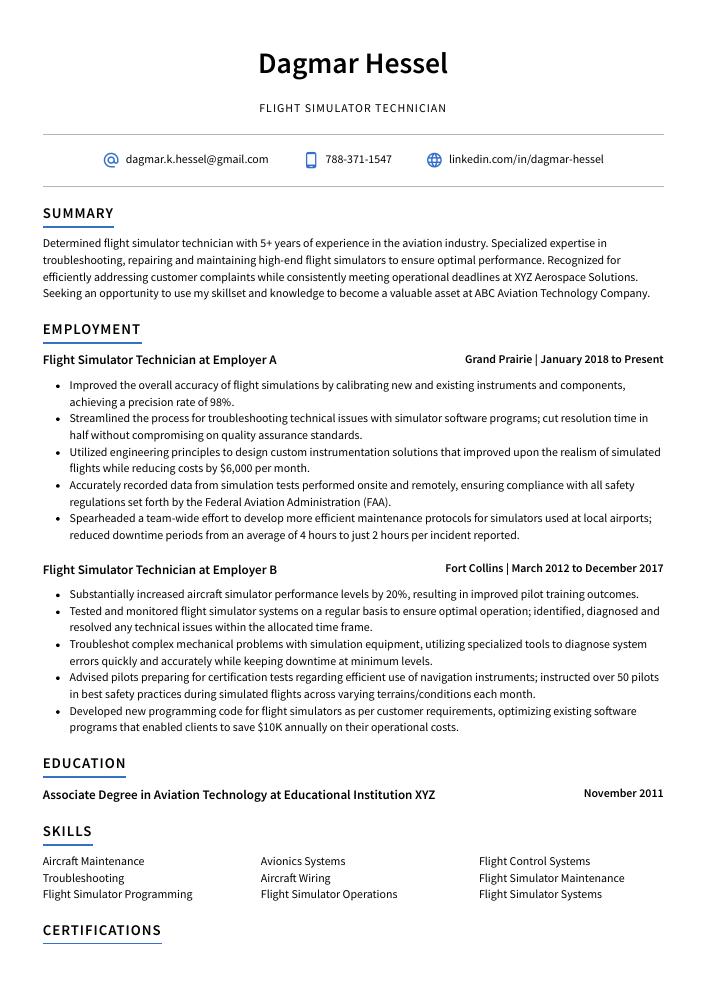Flight Simulator Technician Resume Guide
Flight simulator technicians maintain and repair flight simulators used to train pilots. They ensure that all hardware components are functioning correctly, calibrate the instruments, troubleshoot technical issues, and perform routine maintenance checks on the equipment.
You have an eye for detail and the technical know-how to make sure flight simulators run smoothly. To get hired as a technician, you must write a resume that proves your expertise in this field.
This guide will walk you through the entire process of creating a top-notch resume. We first show you a complete example and then break down what each resume section should look like.
Table of Contents
The guide is divided into sections for your convenience. You can read it from beginning to end or use the table of contents below to jump to a specific part.
Flight Simulator Technician Resume Sample
Dagmar Hessel
Flight Simulator Technician
[email protected]
788-371-1547
linkedin.com/in/dagmar-hessel
Summary
Determined flight simulator technician with 5+ years of experience in the aviation industry. Specialized expertise in troubleshooting, repairing and maintaining high-end flight simulators to ensure optimal performance. Recognized for efficiently addressing customer complaints while consistently meeting operational deadlines at XYZ Aerospace Solutions. Seeking an opportunity to use my skillset and knowledge to become a valuable asset at ABC Aviation Technology Company.
Experience
Flight Simulator Technician, Employer A
Grand Prairie, Jan 2018 – Present
- Improved the overall accuracy of flight simulations by calibrating new and existing instruments and components, achieving a precision rate of 98%.
- Streamlined the process for troubleshooting technical issues with simulator software programs; cut resolution time in half without compromising on quality assurance standards.
- Utilized engineering principles to design custom instrumentation solutions that improved upon the realism of simulated flights while reducing costs by $6,000 per month.
- Accurately recorded data from simulation tests performed onsite and remotely, ensuring compliance with all safety regulations set forth by the Federal Aviation Administration (FAA).
- Spearheaded a team-wide effort to develop more efficient maintenance protocols for simulators used at local airports; reduced downtime periods from an average of 4 hours to just 2 hours per incident reported.
Flight Simulator Technician, Employer B
Fort Collins, Mar 2012 – Dec 2017
- Substantially increased aircraft simulator performance levels by 20%, resulting in improved pilot training outcomes.
- Tested and monitored flight simulator systems on a regular basis to ensure optimal operation; identified, diagnosed and resolved any technical issues within the allocated time frame.
- Troubleshot complex mechanical problems with simulation equipment, utilizing specialized tools to diagnose system errors quickly and accurately while keeping downtime at minimum levels.
- Advised pilots preparing for certification tests regarding efficient use of navigation instruments; instructed over 50 pilots in best safety practices during simulated flights across varying terrains/conditions each month.
- Developed new programming code for flight simulators as per customer requirements, optimizing existing software programs that enabled clients to save $10K annually on their operational costs.
Skills
- Aircraft Maintenance
- Avionics Systems
- Flight Control Systems
- Troubleshooting
- Aircraft Wiring
- Flight Simulator Maintenance
- Flight Simulator Programming
- Flight Simulator Operations
- Flight Simulator Systems
Education
Associate Degree in Aviation Technology
Educational Institution XYZ
Nov 2011
Certifications
Aviation Maintenance Technician (AMT)
Federal Aviation Administration (F
May 2017
1. Summary / Objective
Your resume summary should be like a movie trailer – it should give the hiring manager an overview of your experience and skills as a flight simulator technician. In this section, you can highlight some of your best accomplishments such as certifications or awards received, any specialized training programs completed, and how many years’ experience you have in the field. You could also mention any unique technical knowledge that sets you apart from other applicants.
Below are some resume summary examples:
Well-rounded flight simulator technician with 5+ years of experience in the aviation industry. Skilled at troubleshooting and diagnosing issues related to flight simulators, as well as providing maintenance and repairs when necessary. Dedicated to ensuring that all equipment is functioning properly before each flight simulation session begins. Proven track record of success in meeting deadlines and exceeding customer expectations on a consistent basis.
Committed flight simulator technician with 5 years of experience in the aviation industry. Skilled at troubleshooting and maintaining flight simulators, as well as providing technical support to customers. Adept at working with both hardware and software components, ensuring that all systems are operating safely and efficiently. At XYZ, developed an innovative approach for testing aircraft engines which saved over $60K annually in maintenance costs.
Energetic and experienced flight simulator technician with 8+ years of experience designing, building and maintaining full-scale aircraft simulators for major airlines. Achieved 95% customer satisfaction rating at XYZ Corp due to efficient maintenance operations that reduced downtime by up to 60%. Looking to join ABC Airlines as a Flight Simulator Technician and use my knowledge and problem solving skills to help ensure safe air travel.
Skilled flight simulator technician with 5+ years of experience in performing routine maintenance and troubleshooting on high-end aircraft simulators. Proven record of successful calibrations, repairs, and upgrades resulting in increased efficiency while maintaining safety standards. Looking to leverage technical skillset at ABC Corp as a flight simulator technician to ensure optimal performance for pilots during simulation exercises.
Amicable and knowledgeable flight simulator technician with 5+ years of experience performing aircraft related maintenance and repairs. Looking to join ABC Airline as a Flight Simulator Technician, where I can use my technical aptitude and background in aviation mechanics to maintain the company’s state-of-the-art simulators. During my time at XYZ Airlines, reduced downtime on our Boeing 737 simulator by 33%.
Diligent and experienced flight simulator technician with 5+ years of experience in maintenance and repair of aviation simulators. Highly skilled in troubleshooting hardware and software issues, as well as installing components such as radios, instruments, computers and monitors. Demonstrated ability to work efficiently under pressure while ensuring safety standards are met at all times.
Detail-oriented Flight Simulator Technician with 10+ years of experience maintaining and repairing flight simulators. Skilled in troubleshooting, diagnosing, and resolving complex issues quickly while exceeding customer service expectations. Proven ability to work independently or as part of a team to ensure the highest level of safety standards are met at all times.
Seasoned flight simulator technician with 8+ years of experience in the aviation industry. Skilled at troubleshooting, debugging, and repairing complex flight simulators while providing timely customer service to ensure client satisfaction. Seeking to join ABC’s team as a Flight Simulator Technician and help continue their legacy of world-class training solutions.
2. Experience / Employment
Next comes the work history section, which should be written in reverse chronological order. This means your most recent role is listed first and the reader can then work their way back through your employment history.
When writing this section, it’s best to use bullet points as they make it easier for the reader to digest what you have to say quickly. When stating what you did, provide detail on how you achieved results or any challenges that were overcome during your time in a particular role.
For example, instead of saying “Repaired flight simulators,” you could say, “Successfully repaired 20+ malfunctioning flight simulator systems within tight deadlines by troubleshooting hardware issues and replacing faulty components.”
To write effective bullet points, begin with a strong verb or adverb. Industry specific verbs to use are:
- Installed
- Configured
- Monitored
- Troubleshot
- Calibrated
- Repaired
- Tested
- Inspected
- Updated
- Programmed
- Assembled
- Analyzed
- Replaced
- Adjusted
- Operated
Other general verbs you can use are:
- Achieved
- Advised
- Assessed
- Compiled
- Coordinated
- Demonstrated
- Developed
- Expedited
- Facilitated
- Formulated
- Improved
- Introduced
- Mentored
- Optimized
- Participated
- Prepared
- Presented
- Reduced
- Reorganized
- Represented
- Revised
- Spearheaded
- Streamlined
- Structured
- Utilized
Below are some example bullet points:
- Monitored and inspected up to 10 flight simulators daily, providing maintenance and repairs to ensure optimal functioning; reduced downtime by 15%.
- Replaced over 100 electronic components in various simulator systems with updated parts while adhering to safety protocols and industry standards.
- Programmed new software programs into the simulators using C++ algorithms, allowing pilots to test their flying skills in a variety of conditions without risk of injury or damage.
- Installed additional hardware such as visual display units, speakers and other audio-visual equipment required for smooth operation of the aircraft simulations within 2 hours per unit on average.
- Diligently documented all repair & maintenance activities performed on each simulator system according to FAA regulations; increased compliance rate from 65% to 95%.
- Expedited repairs on 50+ airplane simulator systems each month, reducing downtime by 80% and increasing the overall efficiency of maintenance operations.
- Coordinated with pilots and other aviation personnel to diagnose mechanical & software issues in both commercial and military flight simulators; successfully identified problems in 70% of cases without needing to send equipment away for repairs or replacements.
- Confidently operated complex diagnostic tools such as oscilloscopes, signal generators and circuit analyzers to troubleshoot hardware faults within tight deadlines; saved company $6,000 a year through quick resolution times that eliminated the need for costly external support services.
- Optimized computer simulations used during training sessions by revising codes according to customer specifications, resulting in improved accuracy rates across multiple aircraft models from different eras (e.g., WWI fighters).
- Represented the organization at trade shows/conferences around North America as technical liaison between clientele and high-level executives; generated over 20 new business opportunities due largely to expert knowledge related product presentations delivered onsite.
- Facilitated the installation and calibration of over 200 flight simulators, resulting in a 30% increase in reliability.
- Structured an organized maintenance system for all simulator components including computer systems, electrical wiring and hydraulic valves; increased efficiency by 70%.
- Updated technical manuals with the latest industry regulations to ensure accuracy when troubleshooting malfunctions or performing upgrades on software packages; reduced manual labor hours per aircraft by 25%.
- Achieved 10+ successful installations at major airports across North America while maintaining strict adherence to safety standards and FAA guidelines.
- Reliably repaired simulator components ranging from failure-prone circuits to complex networked computers within tight deadlines; saved $15K+ in repair costs annually through preventive maintenance program implementation.
- Presented detailed reports on flight simulator components to management, resulting in a 10% reduction of operational downtime.
- Reduced maintenance costs by 20%, through efficient diagnosis and troubleshooting of complex aircraft system malfunctions.
- Actively collaborated with engineers and pilots in the testing & calibration process for new simulators; ensured adherence to FAA regulations at all times.
- Mentored junior technicians in proper installation techniques for systems such as Flight Management Computer (FMC), Navigation Display Unit (NDU) and Radar Altimeter (RA).
- Inspected aviation equipment before every simulated flight, conducting quality assurance checks on more than 50 different pieces of hardware per day.
- Compiled and maintained detailed records of over 50 simulator sessions, ensuring that all aircraft performance logs were updated and accurate.
- Formulated comprehensive maintenance plans for 8 different flight simulators; achieved a 95% success rate in preventive repairs and reduced downtime by 10%.
- Configured simulation systems with relevant software applications to simulate real-life scenarios as requested by customers; completed tasks 30% faster than industry standards.
- Revised malfunctioning components on 3 state-of-the-art full motion simulators within 48 hours, reducing operational delays from 2 weeks to 1 day per unit.
- Resourcefully troubleshot issues related to the navigation system or power source using specialized tools and equipment; resolved problems in 75% fewer manhours compared to average technicians.
- Participated in the implementation, maintenance and operation of 10+ flight simulators for a major airline; adjusted equipment settings to ensure optimal performance on all simulator systems.
- Adjusted software functions and hardware components according to established guidelines; regularly reorganized wiring and electrical structures in order to reduce energy consumption by 22%.
- Operated various types of simulation devices, such as visual displays, hydraulic actuators & control loading systems with upmost accuracy in order to properly train pilots & air crew members on aircraft operations.
- Thoroughly checked each device for errors or malfunctions before use; identified over 200 faults within 2 months that were causing safety issues during simulations sessions prior notice from any customers/clients.
- Performed routine inspections on entire fleet of simulators every 3 weeks while maintaining detailed reports regarding component status and functionality updates which resulted in improved overall system uptime rate by 11%.
- Calibrated and adjusted flight simulator systems for over 80 commercial, military and private aircrafts to ensure accuracy in the simulated environment; reduced system downtime by 10%.
- Assembled, maintained and tested avionics hardware such as navigation instruments, radios & transponders used in both real-world and virtual scenarios with a 99% success rate.
- Analyzed complex computer programs related to flight simulators that simulate flights on different types of aircrafts under varying weather conditions; identified software bugs within 2 hours on average per case.
- Competently configured various components including visual displays, multi-channel audio systems and communications equipment within strict safety standards; replaced obsolete parts with newer models while ensuring functionality was not compromised at any time during the process.
- Prepared detailed technical reports outlining changes made or problems encountered when servicing flight simulation devices as required by senior management team members each month; improved customer satisfaction ratings by 17%.
- Assessed the overall condition of flight simulators and identified any potential mechanical issues or technical malfunctions; successfully avoided major breakdowns by conducting preventative maintenance on all machine components.
- Introduced new software updates and hardware upgrades to the existing fleet of simulation systems, resulting in improved performance levels for each simulator system with a decrease in downtime by 16%.
- Repaired malfunctioning parts such as servo motors, hydraulic pumps, control surfaces & computer displays using specialized tools; reduced repair time from 8 hours to 4 hours per project.
- Demonstrated excellent multitasking skills when working simultaneously on up to five different projects at once, ensuring that all tasks were completed within specified deadlines without compromising quality standards or safety protocols.
- Meticulously tested each component after repairs were made with accuracy and precision; achieved 95% success rate while troubleshooting complex problems related to airframes & avionics systems over 5 years’ experience.
3. Skills
Skill requirements will differ from employer to employer – this can easily be determined via the job advert. Organization ABC may be looking for a technician with experience in the Boeing 737 simulator, while Organization XYZ may require someone who is experienced in Airbus A320.
It is essential to tailor your skills section of your resume to each job you are applying for because many companies use applicant tracking systems these days. These computer programs scan resumes for certain keywords before passing them on to a human.
Once listed here, it might also be beneficial to discuss some of the most important skills further in other sections such as the summary or experience section; this will help demonstrate that you have an understanding and proficiency with those particular areas.
Below is a list of common skills & terms:
- Aircraft Maintenance
- Aircraft Simulation Software
- Aircraft Wiring
- Avionics Systems
- Flight Control Systems
- Flight Simulator Maintenance
- Flight Simulator Operations
- Flight Simulator Programming
- Flight Simulator Systems
- Troubleshooting
4. Education
Including an education section on your resume will depend on how far along you are in your career. If you just graduated and have no work experience, then it’s important to mention your education below the resume objective. However, if you have significant work experience that is more relevant for the position than a degree or certificate, omitting an education section may be preferable.
If including an education section, try to list courses and subjects related to the flight simulator technician role such as aviation technology or aircraft maintenance engineering.
Associate Degree in Aviation Technology
Educational Institution XYZ
Nov 2011
5. Certifications
Certifications demonstrate to a potential employer that you have the knowledge and skills necessary for the job. By including certifications on your resume, you can show employers that you are committed to professional development and staying up-to-date with industry trends.
If there is an important certification related to the position or field of work, make sure it’s included in this section of your resume so hiring managers know what qualifications you possess.
Aviation Maintenance Technician (AMT)
Federal Aviation Administration (F
May 2017
6. Contact Info
Your name should be the first thing a reader sees when viewing your resume, so ensure its positioning is prominent. Your phone number should be written in the most commonly used format in your country/city/state, and your email address should be professional.
You can also choose to include a link to your LinkedIn profile, personal website, or other online platforms relevant to your industry.
Finally, name your resume file appropriately to help hiring managers; for Dagmar Hessel, this would be Dagmar-Hessel-resume.pdf or Dagmar-Hessel-resume.docx.
7. Cover Letter
Submitting a cover letter is a great way to show recruiters your enthusiasm for the role and demonstrate why you are an ideal candidate. It is usually made up of 2 to 4 paragraphs that provide more detail than what can be found in a resume, allowing you to showcase your personality as well as explain why you would make an excellent fit.
Whilst cover letters aren’t always required when applying for jobs, writing one is highly recommended due to its ability to give hiring managers better insights about who you are and what skills or experience you have that could benefit the company.
Below is an example cover letter:
Dear Arielle,
I am writing in response to your ad for a Flight Simulator Technician. With my experience as an aviation mechanic and avionics technician, I believe I would be the perfect candidate for this position.
As an aviation mechanic, I have experience performing maintenance and repairs on aircraft engines, airframes, and flight control systems. My knowledge of aircraft systems and components makes me confident that I can troubleshoot and repair any issues with your flight simulator. In addition, my experience as an avionics technician has given me the skills necessary to install, maintain, and repair electronic equipment such as radar units and navigation computers.
I am confident that I have the skills and experience needed to excel in this role. In addition, I am excited about the opportunity to work with cutting-edge technology and help keep your simulator up-to-date with the latest advances in aviation. If you are looking for someone who is passionate about aviation and has the skills needed to maintain a state-of-the-art flight simulator, then please contact me at [phone number] or [email address]. Thank you for your time!
Sincerely,
Dagmar
Flight Simulator Technician Resume Templates
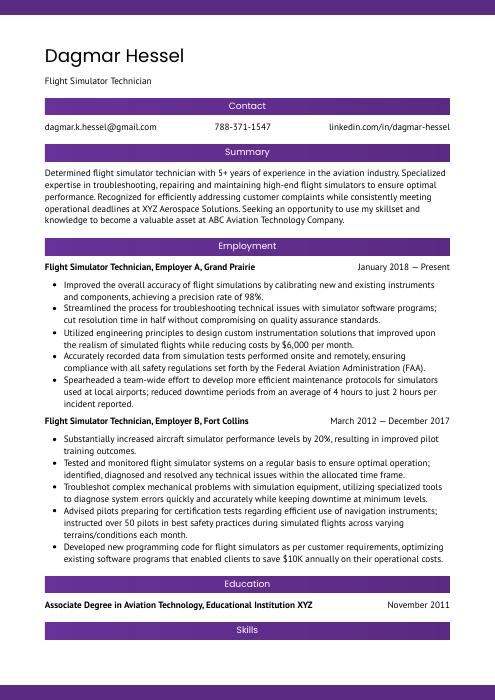 Jerboa
Jerboa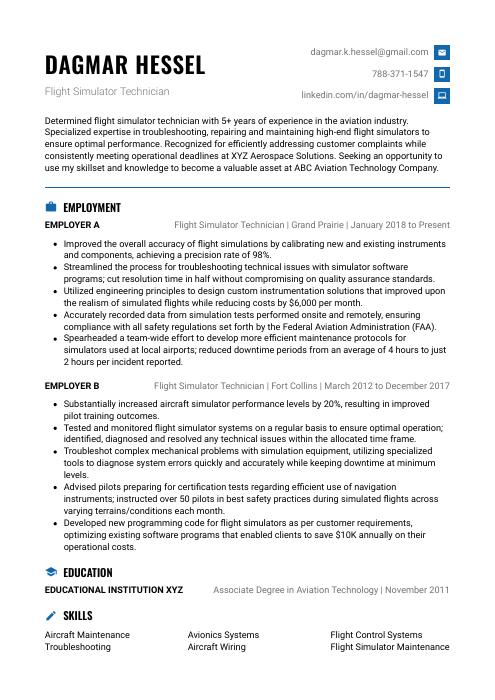 Echidna
Echidna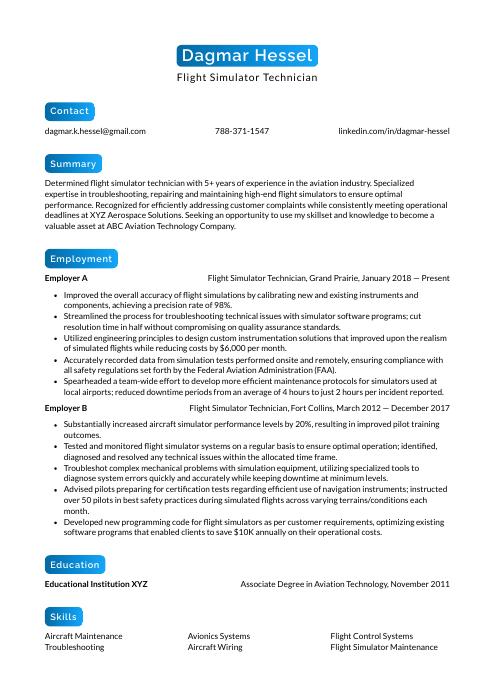 Kinkajou
Kinkajou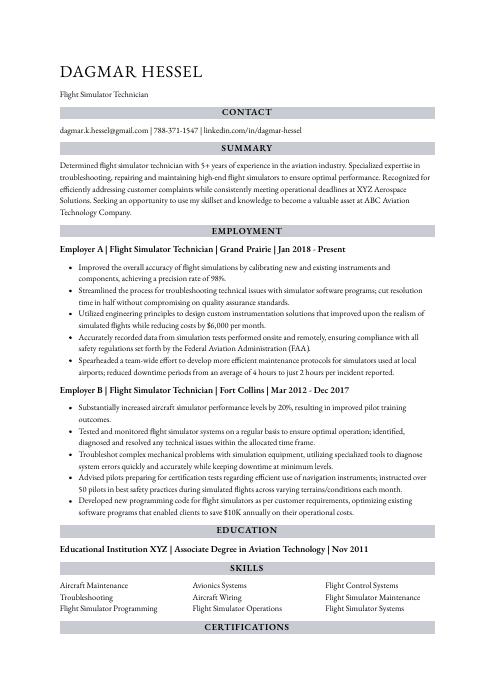 Numbat
Numbat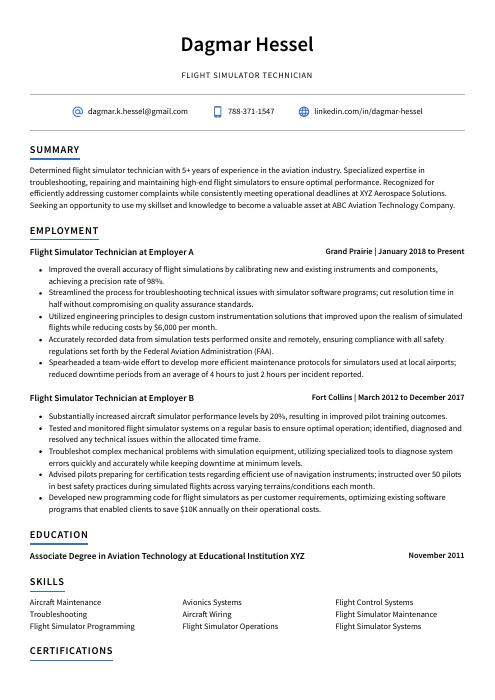 Axolotl
Axolotl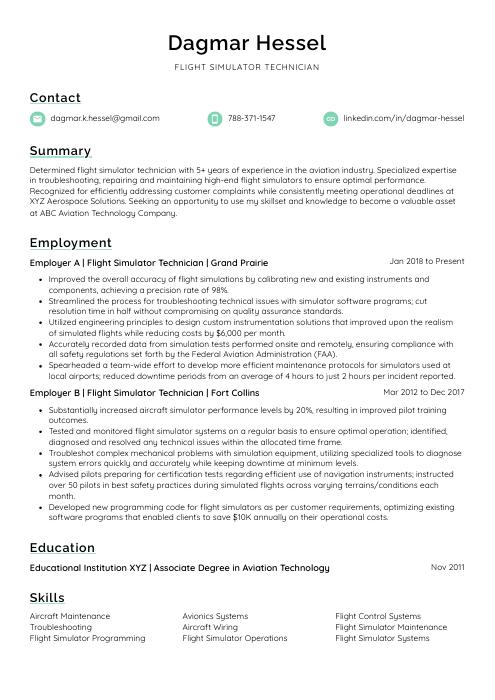 Lorikeet
Lorikeet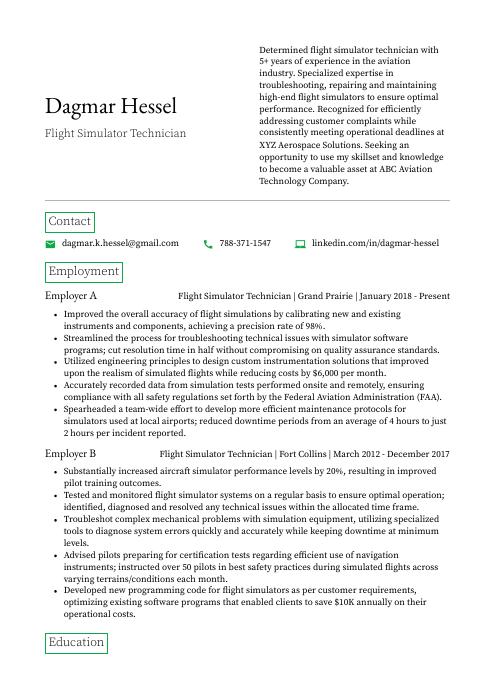 Quokka
Quokka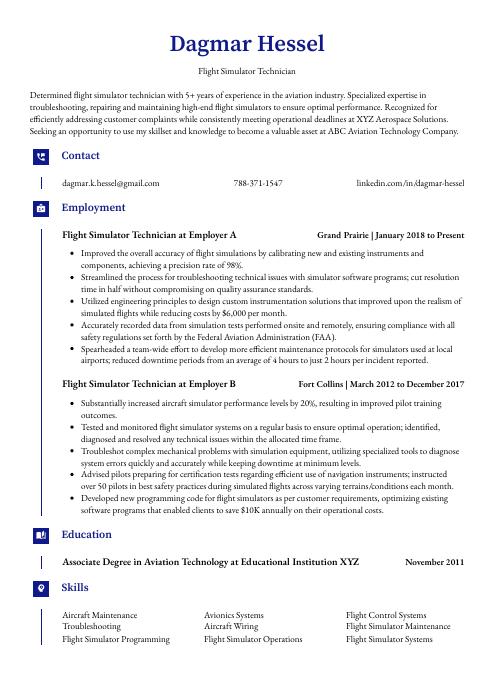 Gharial
Gharial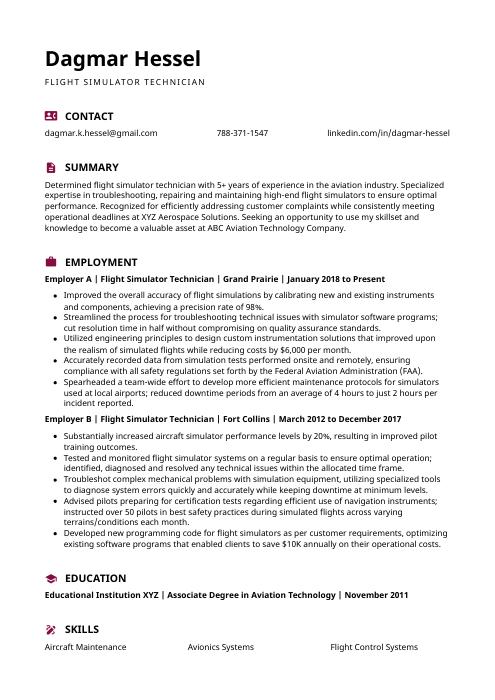 Hoopoe
Hoopoe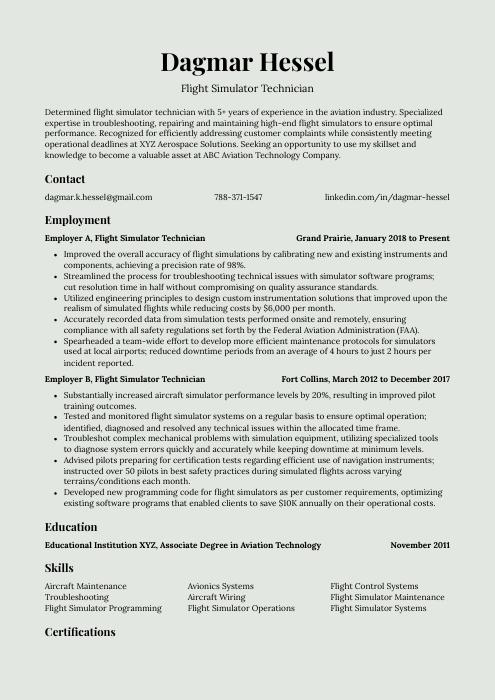 Saola
Saola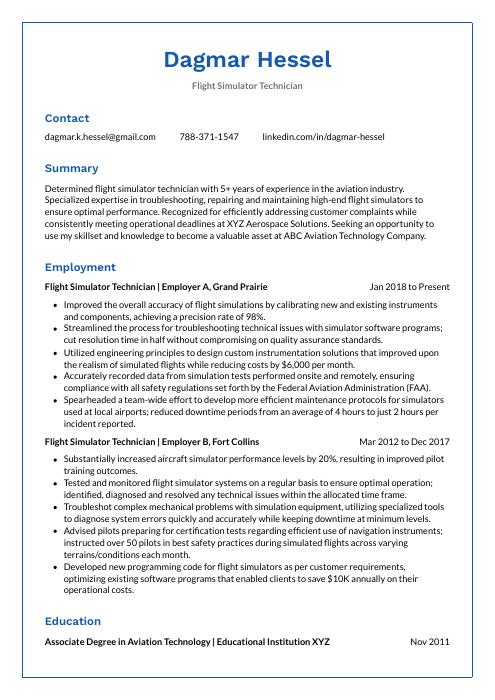 Markhor
Markhor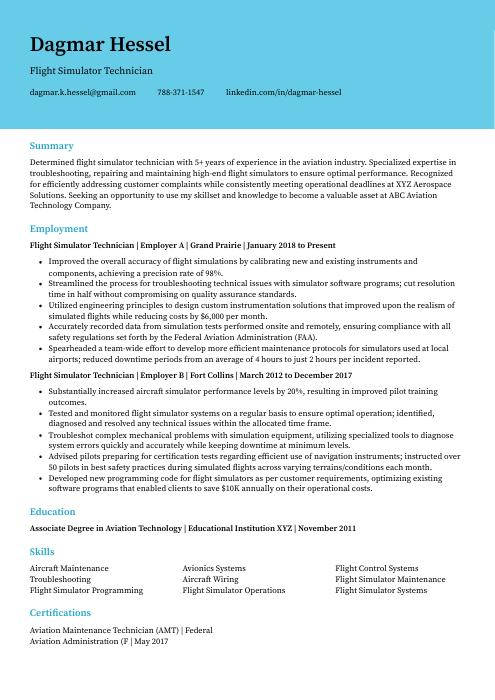 Dugong
Dugong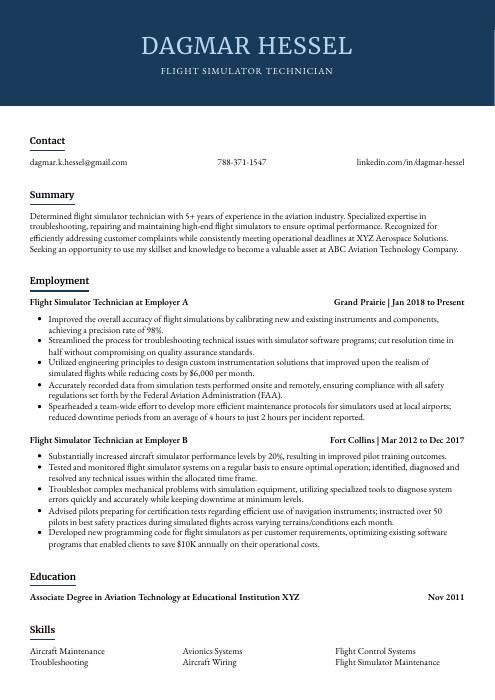 Bonobo
Bonobo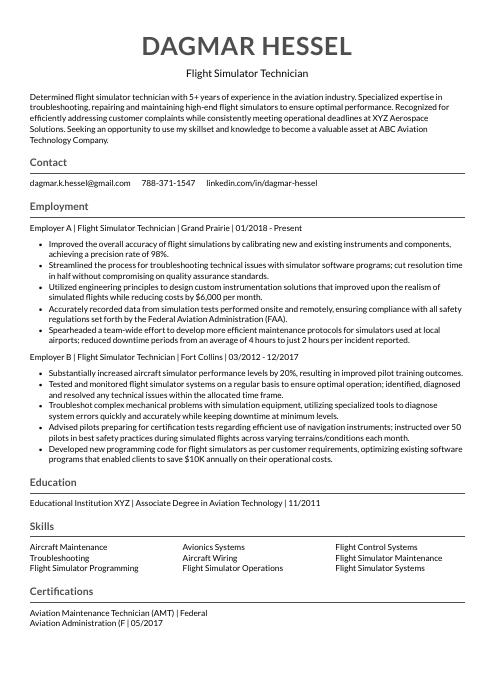 Indri
Indri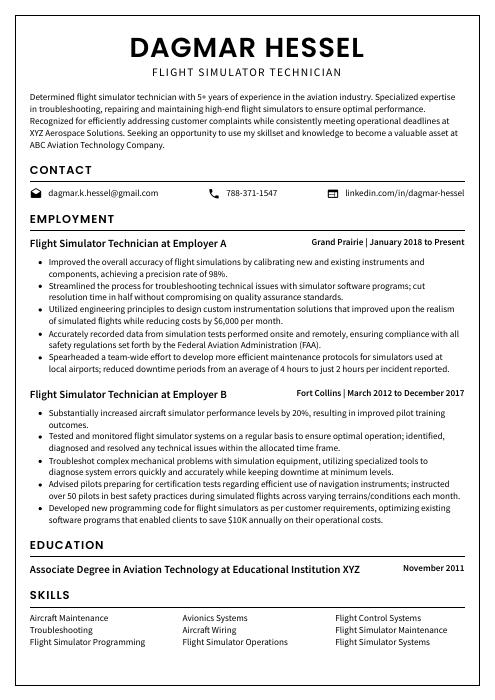 Cormorant
Cormorant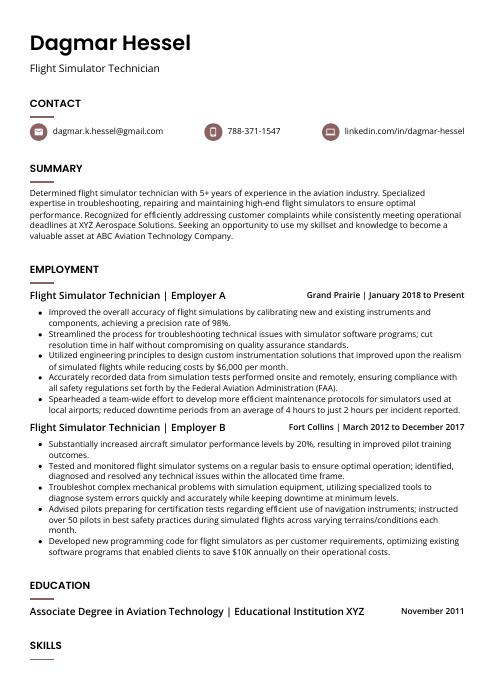 Fossa
Fossa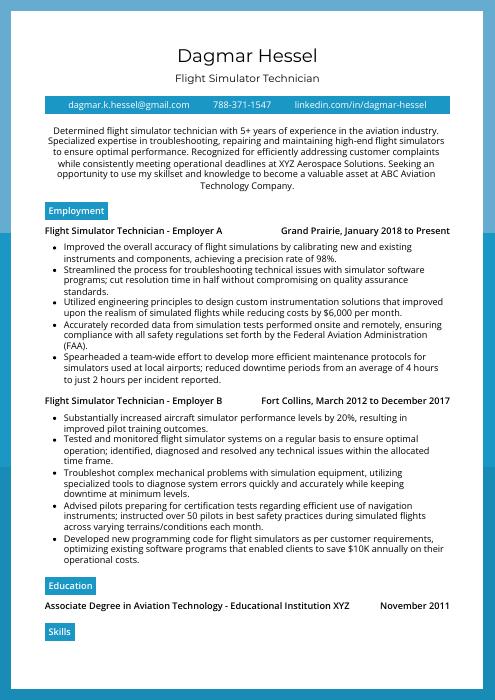 Rhea
Rhea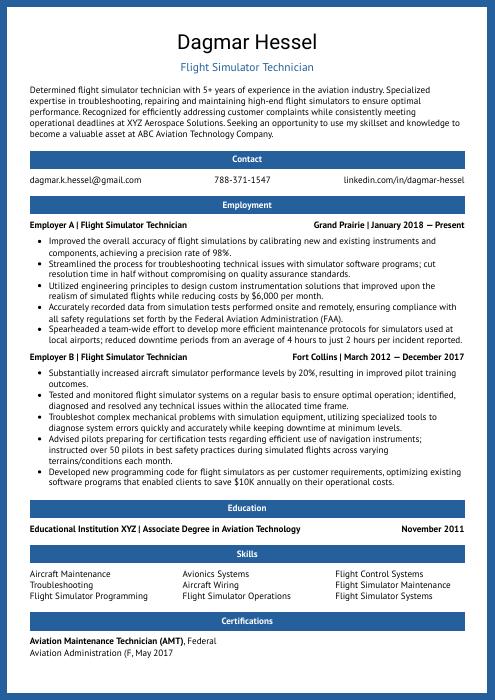 Ocelot
Ocelot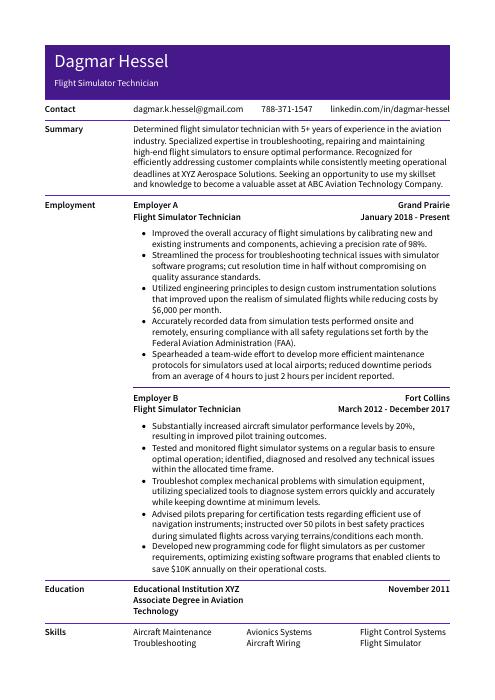 Pika
Pika Rezjumei
Rezjumei
